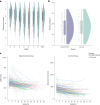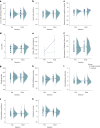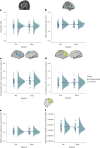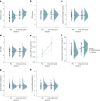Cognitive control training with domain-general response inhibition does not change children's brains or behavior
- PMID: 38834704
- PMCID: PMC11239524
- DOI: 10.1038/s41593-024-01672-w
Cognitive control training with domain-general response inhibition does not change children's brains or behavior
Abstract
Cognitive control is required to organize thoughts and actions and is critical for the pursuit of long-term goals. Childhood cognitive control relates to other domains of cognitive functioning and predicts later-life success and well-being. In this study, we used a randomized controlled trial to test whether cognitive control can be improved through a pre-registered 8-week intervention in 235 children aged 6-13 years targeting response inhibition and whether this leads to changes in multiple behavioral and neural outcomes compared to a response speed training. We show long-lasting improvements of closely related measures of cognitive control at the 1-year follow-up; however, training had no impact on any behavioral outcomes (decision-making, academic achievement, mental health, fluid reasoning and creativity) or neural outcomes (task-dependent and intrinsic brain function and gray and white matter structure). Bayesian analyses provide strong evidence of absent training effects. We conclude that targeted training of response inhibition does little to change children's brains or their behavior.
© 2024. The Author(s).
Conflict of interest statement
N.U.F.D. is a co-founder of Turing Medical. Any potential conflicts of interest have been reviewed and managed by Washington University. N.U.F.D. is a co-inventor of FIRMM Technology 2198 (FIRMM—real-time monitoring and prediction of motion in MRI scans, exclusively licensed to Turing Medical). Any potential conflicts of interest have been reviewed and managed by Washington University. The other authors declare no competing interests.
Figures








Similar articles
-
Kindergarten Children's Executive Functions Predict Their Second-Grade Academic Achievement and Behavior.Child Dev. 2019 Sep;90(5):1802-1816. doi: 10.1111/cdev.13095. Epub 2018 Jun 9. Child Dev. 2019. PMID: 29884983 Free PMC article.
-
No Effect of Commercial Cognitive Training on Brain Activity, Choice Behavior, or Cognitive Performance.J Neurosci. 2017 Aug 2;37(31):7390-7402. doi: 10.1523/JNEUROSCI.2832-16.2017. Epub 2017 Jul 10. J Neurosci. 2017. PMID: 28694338 Free PMC article.
-
Targeting self-regulation and academic functioning among preschoolers with behavior problems: Are there incremental benefits to including cognitive training as part of a classroom curriculum?Child Neuropsychol. 2019 Jul;25(5):688-704. doi: 10.1080/09297049.2018.1526271. Epub 2018 Sep 26. Child Neuropsychol. 2019. PMID: 30253700
-
Cognitive and neural plasticity in old age: A systematic review of evidence from executive functions cognitive training.Ageing Res Rev. 2019 Aug;53:100912. doi: 10.1016/j.arr.2019.100912. Epub 2019 May 30. Ageing Res Rev. 2019. PMID: 31154013
-
Development of metacognitive and emotional executive functions in children.Appl Neuropsychol Child. 2013;2(2):82-7. doi: 10.1080/21622965.2013.748388. Epub 2013 Jan 28. Appl Neuropsychol Child. 2013. PMID: 23848243 Review.
Cited by
-
Newly trained navigation and verbal memory skills elicit changes in task-related networks but not brain structure.bioRxiv [Preprint]. 2025 Aug 14:2025.04.14.648747. doi: 10.1101/2025.04.14.648747. bioRxiv. 2025. PMID: 40832201 Free PMC article. Preprint.
-
Interplay between preclinical indices of obesity and neural signatures of fluid intelligence in youth.Commun Biol. 2024 Oct 9;7(1):1285. doi: 10.1038/s42003-024-06924-w. Commun Biol. 2024. PMID: 39379610 Free PMC article.
-
Parental reflective functioning and internalizing symptoms predict altruistic prosocial behaviour in children.Br J Dev Psychol. 2025 Sep;43(3):755-770. doi: 10.1111/bjdp.12551. Epub 2025 Feb 17. Br J Dev Psychol. 2025. PMID: 39962726 Free PMC article.
-
Structural brain basis of latent factors of executive functions in childhood.Dev Cogn Neurosci. 2025 Jan;71:101504. doi: 10.1016/j.dcn.2024.101504. Epub 2024 Dec 28. Dev Cogn Neurosci. 2025. PMID: 39787640 Free PMC article.
References
-
- Hoffmann F, Singer T, Steinbeis N. Children’s increased emotional egocentricity compared to adults is mediated by age-related differences in conflict processing. Child Dev. 2015;86:765–780. - PubMed
-
- McAuliffe K, Blake PR, Steinbeis N, Warneken F. The developmental foundations of human fairness. Nat. Hum. Behav. 2017;1:0042.
-
- Steinbeis, N. Taxing behavioral control diminishes sharing and costly punishment in childhood. Dev. Sci.21, e12492 (2018). - PubMed
-
- Steinbeis N, Bernhardt BC, Singer T. Impulse control and underlying functions of the left DLPFC mediate age-related and age-independent individual differences in strategic social behavior. Neuron. 2012;73:1040–1051. - PubMed
Publication types
MeSH terms
Grants and funding
- Fellowship/Jacobs Foundation
- R01 MH096773/MH/NIMH NIH HHS/United States
- 2019-1356-04/Jacobs Foundation
- 715282/EC | EU Framework Programme for Research and Innovation H2020 | H2020 Priority Excellent Science | H2020 European Research Council (H2020 Excellent Science - European Research Council)
- R44 MH121276/MH/NIMH NIH HHS/United States
LinkOut - more resources
Full Text Sources

